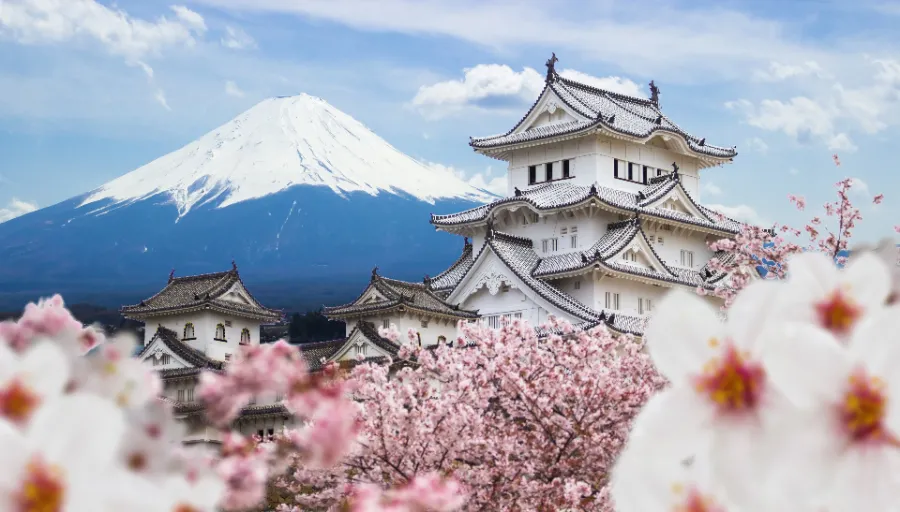What makes Himeji Castle so fascinating? It’s a question many travelers ask when planning a visit. This ancient fortress is a National Treasure of Japan and a UNESCO World Heritage Site. For anyone captivated by Japanese history and culture, this architectural gem is an absolute must-see.
1. Where Is Himeji Castle?
Himeji Castle sits at the heart of Himeji City in Hyogo Prefecture, Japan. Often called “White Heron Castle,” it draws its nickname from the graceful bird, a symbol of purity and nobility in Japanese culture. Alongside Matsumoto and Kumamoto castles, Himeji ranks among Japan’s “Three Precious Castles,” celebrated as a trio of national treasures and a top draw for international visitors.
2. The History of Himeji Castle
The story of Himeji Castle began in 1333, when Lord Norimura Akamatsu of Harima ordered its construction as a defensive stronghold. In 1346, his son Sadanori expanded it with living quarters and additional structures to support the clan’s daily life and operations.
By 1545, the Kuroda lords seized control under the Kodera clan’s command, renovating the fortress into what became Himeji Castle. The structure was completed in 1561. In 1580, Toyotomi Hideyoshi, a prominent Sengoku-era daimyo, arrived and added a three-story tower of his own.
In 1600, after his victory at Sekigahara, Tokugawa Ieyasu handed the castle to his son-in-law, Terumasa Ikeda. Ikeda demolished Hideyoshi’s tower and began building a new castle, digging three moats around it starting in 1601. This massive project, finished in 1609, took nine years and millions of labor hours. After Ikeda’s death in 1613, his son inherited the castle but passed away three years later.
In 1617, Tadamasa Honda, an early Edo-period lord, took over and added several buildings, including a special tower for his daughter-in-law, Princess Sen. The castle was fully completed in 1618. Over time, after the Honda clan’s rule ended, lords from the Matsudaira and Sakakibara clans took charge, each leaving their mark on this historic site.
3. What Makes Visiting Himeji Castle Special?
3.1. How to Get to Himeji Castle from Osaka, Kobe, or Tokyo
Himeji lies about 650 kilometers west of Tokyo. From Kyoto, the Shinkansen takes around 44 minutes, while the JR train takes roughly 1 hour and 38 minutes and is more budget-friendly. From Osaka, less than 100 kilometers away, the JR train takes about 1 hour and 5 minutes. Alternatively, the Shinkansen from Osaka requires a transfer at Shin-Osaka and takes about 50 minutes total—since it’s not much faster and involves a switch, the JR option is often the smarter pick.
Kobe, just 55 kilometers east, is the closest starting point. Buses or subways from Kobe to Himeji Station are convenient options, with travel times varying slightly. Taxis are faster but far pricier. From Himeji Station, it’s a quick 3-5 minute bus ride or a 15-20 minute walk to the castle.
3.2. What Makes Himeji Castle Famous?
A Striking Hilltop Location
Perched atop Himeyama Hill at 45.6 meters above sea level, Himeji Castle commands attention. Stretching 950-1,600 meters north to south and 900-1,700 meters east to west, it spans 233 hectares with a 4,200-meter perimeter—50 times larger than Tokyo Dome and 60 times bigger than Koshien Stadium. Building such a sprawling fortress on a hill was no small feat, showcasing the ingenuity and effort of Japan’s past, which continues to captivate curious travelers.
Unique Exterior Architecture
From the outside, Himeji’s medieval defense towers stand out. The complex includes 83 buildings, 74 of which are designated Important Cultural Properties. Originally wooden, the castle was coated with a white plaster mix of uncolored mortar, hemp, and water, evoking a noble heron. This finish isn’t just beautiful—it’s fireproof, waterproof, and bullet-resistant. The silver-gray tiled roofs, made from 56 distinct tile types, feature intricate triangular edge designs that channel rainwater into a gutter system for daily use.
A dry stone well south of the castle ties into the eerie tale of Okiku, a favored concubine accused of theft, whose restless spirit is said to linger.
Intricate Interior Design
Inside, Himeji dazzles with its main tower and maze-like corridors. With 84 uniquely named gates—tricky to pronounce and navigate—first-timers might loop back to the start without clear directions. Thankfully, signs guide the way. The six-story structure rests on massive wooden pillars, some over 780 years old, sourced from ancient cypress trees, while stone pillars at the gates boast ornate carvings.
Staircases zigzag unpredictably between floors, doubling as defensive choke points. Long, winding hallways enhance security, connecting generals’ quarters, soldiers’ rooms, and women’s chambers. Small, narrow windows—once archer posts—now offer panoramic views of the park and city below.
Aerial Perspective
From above, Himeji resembles an oval oasis, encircled by a deep moat and sturdy stone walls. Pine and cypress trees dot the grounds, blending with koi ponds to create a serene, picturesque scene.
3.3. Himeji Castle in Autumn Foliage Season
Autumn transforms Himeji into a painterly wonder, especially at Kokoen Garden nearby. This garden, with nine distinct sections framed by Edo-style walls, glows with red and gold leaves. From its central corridor, you can explore surrounding buildings, admire ponds and waterfalls, or relax at a restaurant with garden views. The Momiji Festival at night, with its illuminated foliage, adds a magical touch—think moon-gazing, tea ceremonies, and traditional music performances.
3.4. Himeji Castle in Cherry Blossom Season
Spring brings a romantic yet majestic vibe as cherry blossoms bloom around Himeji. The pink petals contrast beautifully with the castle’s white-gray tones, while lush pines bask in the warm weather. Locals and tourists flock here to soak in this dreamy blend of nature and history.
4. Dining in Himeji
After touring the castle, unwind with a local Kirin beer—a bittersweet brew blending Asahi’s richness with Sapporo’s crispness. Pair it with these Himeji favorites: anago (grilled eel) from a basement eatery near the main shopping street, tamago kake gohan (raw egg over rice) with pickles and soy sauce, fresh seafood and sashimi, sake from a bar with dozens of varieties, or Himeji oden—a hearty mix of eggs, radish, tofu, taro, and fish cakes in soy broth.
Himeji Castle remains a stunning testament to Japan’s architectural and military heritage. This guide aims to spark your curiosity about this historic gem—whether you’re drawn by its past, its beauty, or its flavors, Himeji won’t disappoint.











